#Bay of Aboukir
Explore tagged Tumblr posts
Text
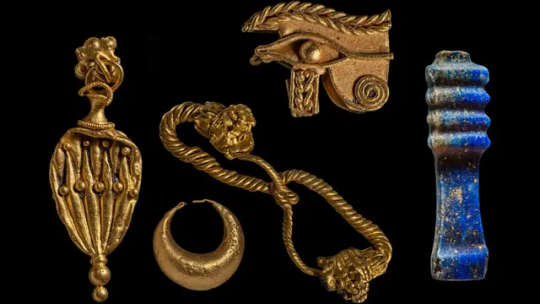
Sunken Temples of Aphrodite and Amun Found off Egyptian Coast
New discoveries off Egyptian coast reveal ‘treasures and secrets
New “treasures and secrets” have been revealed at the site of a sunken temple off Egypt’s Mediterranean coast, the European Institute for Underwater Archaeology (IEASM) announced in a news release Tuesday.
An underwater archaeological team, led by French marine archaeologist Franck Goddio, has made further discoveries at the site of a temple to god Amun in the ancient port city of Thonis-Heracleion in the Bay of Aboukir, the institute said.
The team investigated the city’s south canal, where huge blocks of stone from the ancient temple collapsed “during a cataclysmic event dated to the mid-second century BC,” the institute said.
The temple to god Amun was where pharaohs came “to receive the titles of their power as universal kings from the supreme god of the ancient Egyptian pantheon,” it said.
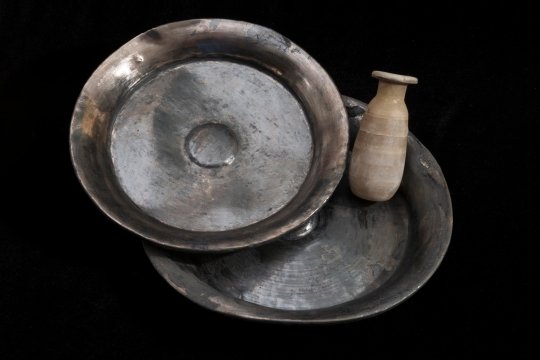
“Precious objects belonging to the temple treasury have been unearthed, such as silver ritual instruments, gold jewelry and fragile alabaster containers for perfumes or unguents,” IEASM said. “They bear witness to the wealth of this sanctuary and the piety of the former inhabitants of the port city.”
The archaeological excavations, conducted jointly by Goddio’s team and the Department of Underwater Archaeology of the Ministry of Tourism and Antiquities of Egypt, revealed underground structures “supported by very well-preserved wooden posts and beams dating from the 5th century BC,” the institute said.
“It is extremely moving to discover such delicate objects, which survived intact despite the violence and magnitude of the cataclysm,” said Goddio, who is president of IEASM and director of excavations.
The discoveries were made possible thanks to the development and use of new geophysical prospecting technologies that can detect cavities and objects “buried under layers of clay several meters thick,” the institute said.

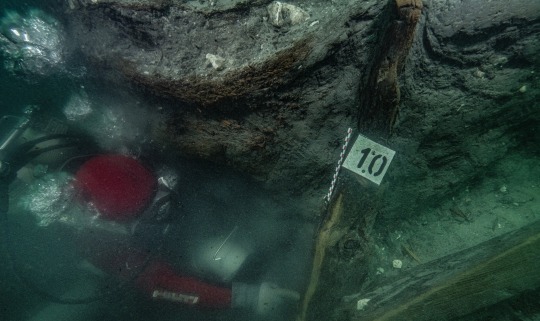
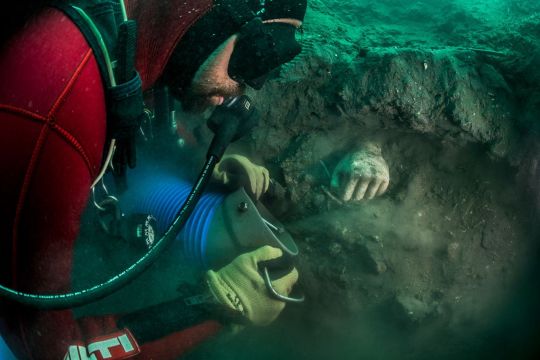
Relics from Greek presence, too
East of the Amun temple, a Greek sanctuary devoted to Aphrodite was discovered containing bronze and ceramic objects.
“This illustrates that Greeks who were allowed to trade and settle in the city during the time of the Pharaohs of the Saïte dynasty (664 - 525 BC) had their sanctuaries to their own gods,” the institute said.
The discoveries of Greek weapons also reveal the presence of Greek mercenaries in the area, IEASM said. “They were defending the access to the Kingdom at the mouth of the Canopic Branch of the Nile. This branch was the largest and the best navigable one in antiquity.”
The remains of Thonis-Heracleion are now located under the sea, 7 kilometers (4.3 miles) from the present coast of Egypt, IEASM said. The city was for centuries Egypt’s largest port on the Mediterranean before the founding of Alexandria by Alexander the Great in 331 BC.
“Rising sea levels and earthquakes followed by tidal waves triggering land liquefaction events, caused a 110 square kilometer portion of the Nile delta to totally disappear under the sea, taking with it the city of Thonis-Heracleion,” the institute said.
The city was discovered by the IEASM in 2000.
By Radina Gigova.
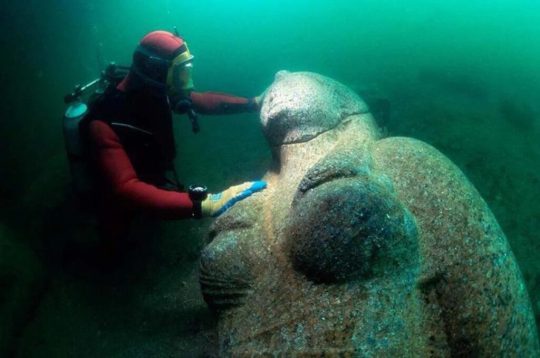
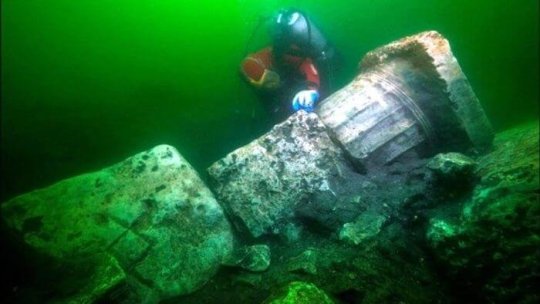
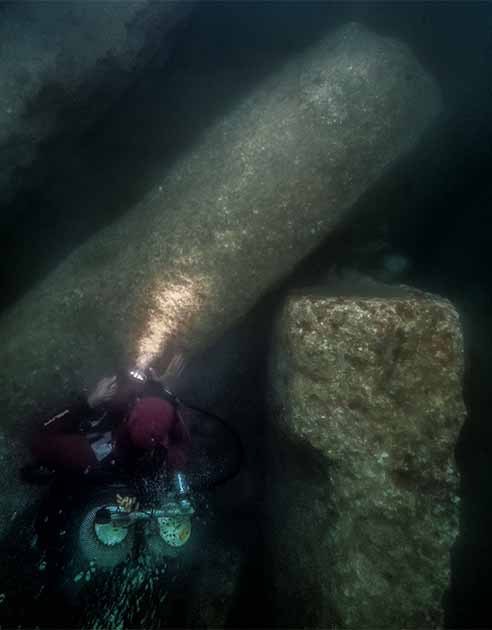
#Sunken Temples of Aphrodite and Amun Found off Egyptian Coast#Thonis-Heracleion#Bay of Aboukir#gold#gold treasure#ancient artifacts#archeology#archeolgst#history#history news#ancient history#ancient culture#ancient civilizations#ancient egypt#egyptian history#egyptian mythology#greek history
309 notes
·
View notes
Text

The Destruction of L'Orient at the Battle of the Nile, 1 August 1798. British boats rescue French survivors as L'Orient sinks in flames by Peter Johann Nepomuk Geiger
#peter johann nepomuk geiger#art#battle of the nile#french revolutionary wars#egypt#l'orient#warship#warships#england#france#great britain#english#british#french#age of sail#marine art#naval art#maritime art#mediterranean#boat#boats#sea#history#europe#european#napoleonic#aboukir bay#ships
115 notes
·
View notes
Text
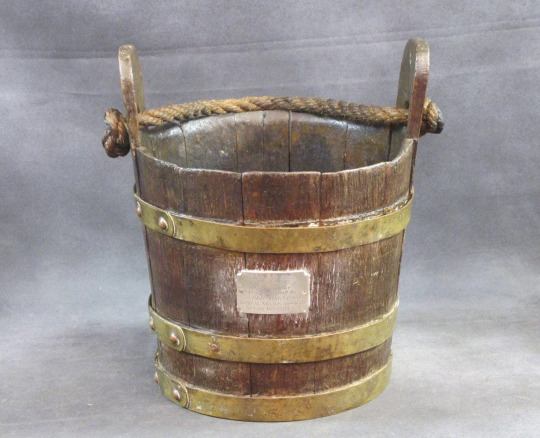
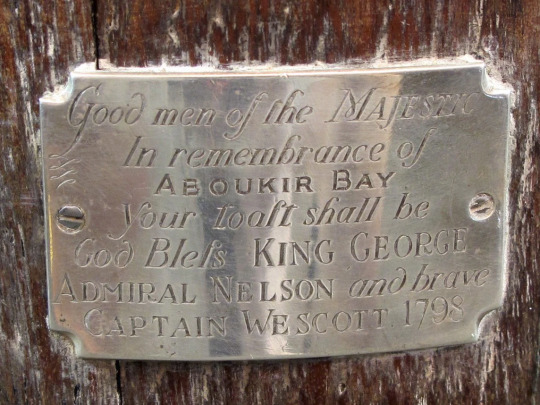
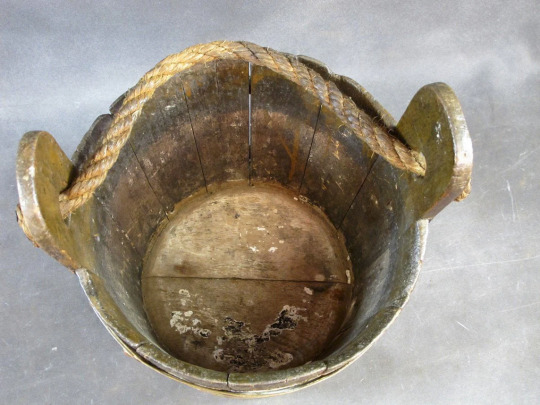
An original grog bucket from HMS Majesty, a 74 Gun third-rate ship of the line launched in 1785 at Deptford, England fought at Aboukir Bay, known as "The Battle of the Nile" under the command of Captain George Blagdon Westcott who was killed in during the action. Incribed : "Good men of the MAJESTIC. In remembrance of ABOUKIR BAY. Your toast shall be God Bless KING GEORGE, ADMIRAL NELSON and brave CAPTAIN WESTCOTT. 1798"
The contents of this bucket is of course not enough for the whole crew. But the grog was usually distributed from the barrel in such buckets to the individual divisions to avoid long queues.
63 notes
·
View notes
Text
It is a city shrouded in myth, swallowed by the Mediterranean Sea and buried in sand and mud for more than 1,200 years. But now archeologists are unearthing the mysteries of Heracleion, uncovering amazingly well-preserved artifacts that tell the story of a vibrant classical-era port.
Known as Heracleion to the ancient Greeks and Thonis to the ancient Eygptians, the city was rediscovered in 2000 by French underwater archaeologist Dr. Franck Goddio and a team from the European Institute for Underwater Acheology (IEASM) after a four-year geophysical survey. The ruins of the lost city were found 30 feet under the surface of the Mediterranean Sea in Aboukir Bay, near Alexandria.
A new documentary highlights the major discoveries that have been unearthed at Thonis-Heracleion during a 13-year excavation. Exciting archeological finds help describe an ancient city that was not only a vital international trade hub but possibly an important religious center. The television crew used archeological survey data to construct a computer model of the city
According to the Telegraph, leading research now suggests that Thonis-Heracleion served as a mandatory port of entry for trade between the Mediterranean and the Nile.
So far, 64 ancient shipwrecks and more than 700 anchors have been unearthed from the mud of the bay, the news outlet notes. Other findings include gold coins, weights from Athens (which have never before been found at an Egyptian site) and giant tablets inscribed in ancient Greek and ancient Egyptian. Researchers think that these artifacts point to the city's prominence as a bustling trade hub.
Researchers have also uncovered a variety of religious artifacts in the sunken city, including 16-foot stone sculptures thought to have adorned the city's central temple and limestone sarcophagi that are believed to have contained mummified animals.








4 notes
·
View notes
Photo
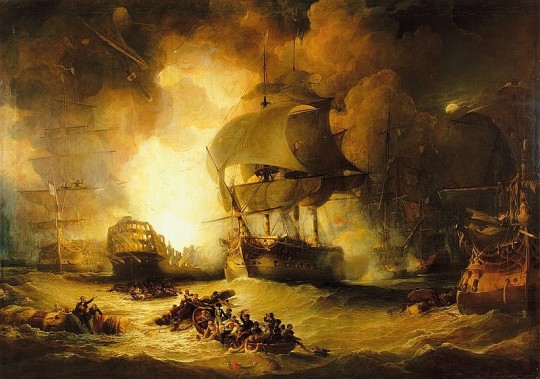
Battle of the Nile
The Battle of the Nile (1-2 August 1798), or the Battle of Aboukir Bay, saw a British fleet led by Rear-Admiral Sir Horatio Nelson (1758-1805) destroy a French fleet at Aboukir Bay near the Rosetta mouth of the Nile River. It was one of the most decisive naval battles of the French Revolutionary and Napoleonic Wars.
Continue reading...
39 notes
·
View notes
Text

Cleopatra - Queen of Egypt
Found underwater in Cleopatra Palace in Alexandria, Egypt
This 7.2ft-high granite statue is one of the greatest finds from Franck Goddio's ongoing exploration of the Bay of Aboukir, near Alexandria.
The statue shows the queen dressed as Isis, and wearing traditional royal robes associated with the goddess. Her hair in particular shows careful attention to detail, and she wears a diadem (crown) decorated with the uraeus snake, emblem of Egypt.
8 notes
·
View notes
Text
New “treasures and secrets” have been revealed at the site of a sunken temple off Egypt’s Mediterranean coast, the European Institute for Underwater Archaeology (IEASM) announced in a news release Tuesday.
An underwater archaeological team, led by French marine archaeologist Franck Goddio, has made further discoveries at the site of a temple to god Amun in the ancient port city of Thonis-Heracleion in the Bay of Aboukir, the institute said.
The team investigated the city’s south canal, where huge blocks of stone from the ancient temple collapsed “during a cataclysmic event dated to the mid-second century BC,” the institute said.
The temple to god Amun was where pharaohs came “to receive the titles of their power as universal kings from the supreme god of the ancient Egyptian pantheon,” it said.
“Precious objects belonging to the temple treasury have been unearthed, such as silver ritual instruments, gold jewelry and fragile alabaster containers for perfumes or unguents,” IEASM said.
“They bear witness to the wealth of this sanctuary and the piety of the former inhabitants of the port city.”
The archaeological excavations, conducted jointly by Goddio’s team and the Department of Underwater Archaeology of the Ministry of Tourism and Antiquities of Egypt, revealed underground structures “supported by very well-preserved wooden posts and beams dating from the 5th century BC,” the institute said.
“It is extremely moving to discover such delicate objects, which survived intact despite the violence and magnitude of the cataclysm,” said Goddio, who is president of IEASM and director of excavations.
The discoveries were made possible thanks to the development and use of new geophysical prospecting technologies that can detect cavities and objects “buried under layers of clay several meters thick,” the institute said.
Relics from Greek presence, too
East of the Amun temple, a Greek sanctuary devoted to Aphrodite was discovered containing bronze and ceramic objects.
“This illustrates that Greeks who were allowed to trade and settle in the city during the time of the Pharaohs of the Saïte dynasty (664 - 525 BC) had their sanctuaries to their own gods,” the institute said.
The discoveries of Greek weapons also reveal the presence of Greek mercenaries in the area, IEASM said. “They were defending the access to the Kingdom at the mouth of the Canopic Branch of the Nile. This branch was the largest and the best navigable one in antiquity.”
The remains of Thonis-Heracleion are now located under the sea, 7 kilometers (4.3 miles) from the present coast of Egypt, IEASM said. The city was for centuries Egypt’s largest port on the Mediterranean before the founding of Alexandria by Alexander the Great in 331 BC.
“Rising sea levels and earthquakes followed by tidal waves triggering land liquefaction events, caused a 110 square kilometer portion of the Nile delta to totally disappear under the sea, taking with it the city of Thonis-Heracleion,” the institute said.
The city was discovered by the IEASM in 2000.
3 notes
·
View notes
Text
Events 8.1 (before 1920)
30 BC – Octavian (later known as Augustus) enters Alexandria, Egypt, bringing it under the control of the Roman Republic. AD 69 – Batavian rebellion: The Batavians in Germania Inferior (Netherlands) revolt under the leadership of Gaius Julius Civilis. 527 – Justinian I becomes the sole ruler of the Byzantine Empire. 607 – Ono no Imoko is dispatched as envoy to the Sui court in China (Traditional Japanese date: July 3, 607). 902 – Taormina, the last Byzantine stronghold in Sicily, is captured by the Aghlabid army, concluding the Muslim conquest of Sicily. 1203 – Isaac II Angelos, restored Byzantine Emperor, declares his son Alexios IV Angelos co-emperor after pressure from the forces of the Fourth Crusade. 1291 – The Old Swiss Confederacy is formed with the signature of the Federal Charter. 1469 – Louis XI of France founds the chivalric order called the Order of Saint Michael in Amboise. 1498 – Christopher Columbus becomes the first European to visit what is now Venezuela. 1571 – The Ottoman conquest of Cyprus is concluded, by the surrender of Famagusta. 1620 – Speedwell leaves Delfshaven to bring pilgrims to America by way of England. 1664 – Ottoman forces are defeated in the battle of Saint Gotthard by an Austrian army led by Raimondo Montecuccoli, resulting in the Peace of Vasvár. 1714 – George, Elector of Hanover, becomes King George I of Great Britain, marking the beginning of the Georgian era of British history. 1759 – Seven Years' War: The Battle of Minden, an allied Anglo-German army victory over the French. In Britain this was one of a number of events that constituted the Annus Mirabilis of 1759 and is celebrated as Minden Day by certain British Army regiments. 1774 – British scientist Joseph Priestley discovers oxygen gas, corroborating the prior discovery of this element by German-Swedish chemist Carl Wilhelm Scheele. 1798 – French Revolutionary Wars: Battle of the Nile (Battle of Aboukir Bay): Battle begins when a British fleet engages the French Revolutionary Navy fleet in an unusual night action. 1800 – The Acts of Union 1800 are passed which merge the Kingdom of Great Britain and the Kingdom of Ireland into the United Kingdom of Great Britain and Ireland. 1801 – First Barbary War: The American schooner USS Enterprise captures the Tripolitan polacca Tripoli in a single-ship action off the coast of modern-day Libya. 1834 – Slavery is abolished in the British Empire as the Slavery Abolition Act 1833 comes into force, although it remains legal in the possessions of the East India Company until the passage of the Indian Slavery Act, 1843. 1834 – Construction begins on the Wilberforce Monument in Kingston Upon Hull. 1842 – The Lombard Street riot erupts in Philadelphia, Pennsylvania, United States. 1849 – Joven Daniel wrecks at the coast of Araucanía, Chile, leading to allegations that local Mapuche tribes murdered survivors and kidnapped Elisa Bravo. 1855 – The first ascent of Monte Rosa, the second highest summit in the Alps. 1863 – At the suggestion of Senator J. V. Snellman and the order of Emperor Alexander II, full rights are promised to the Finnish language by a language regulation in the Grand Duchy of Finland. 1876 – Colorado is admitted as the 38th U.S. state. 1893 – Henry Perky patents shredded wheat. 1894 – The Empire of Japan and Qing China declare war on each other after a week of fighting over Korea, formally inaugurating the First Sino-Japanese War. 1907 – The start of the first Scout camp on Brownsea Island, the origin of the worldwide Scouting movement. 1911 – Harriet Quimby takes her pilot's test and becomes the first U.S. woman to earn an Aero Club of America aviator's certificate. 1914 – World War I: The German Empire declares war on the Russian Empire. 1914 – World War I: The Swiss Army mobilizes because of World War I. 1915 – Patrick Pearse gives his famous speech "Ireland unfree shall never be at peace" at O'Donovan Rossa's funeral in Dublin.
0 notes
Text
The Pharaoh's Secret / Clive Cussler
NUMA Files #13
Een mysterieuze gifdamp legt bijna de gehele bevolking van Lampedusa, inclusief de bemanning van een NUMA onderzoekslocatie, in coma. Kurt Austin en Joe Zavalla bundelen krachten met een Italiaanse agente en onderzoeken een Egyptische geheime organisatie in Cairo. Paul en Gamay Trout volgen een spoor van een Franse wetenschapper die mee was met de Egyptische expeditie van Napoleon. Blijkbaar ontdekten de oude Egyptenaren een 'zwarte mist', maar ook het tegengif ervoor, dat ze in handen moeten krijgen voor het te laat is.
Kurt wasn’t really listening, his eyes were drawn back to the painting. Something was off, something they’d overlooked. “The Battle of Aboukir Bay was fought in 1799,” he said. “Correct,” Etienne said. “Seventeen ninety-nine . . .” he said. Suddenly, it dawned on him. He turned. “You said Emile’s translation referred to this Mist of Life, but the Rosetta stone and a basic understanding of Egyptian hieroglyphics didn’t happen for at least another fifteen years.” Etienne paused. He seemed taken aback by the thought. “What are you suggesting? That Emile falsified his translation?” “For our sake, let’s hope not,” Kurt said. “But if the artifacts went down on the Sophie C. years before the Rosetta stone was translated, how would anyone know what was written on them?” Etienne looked as if he was about to speak but swallowed his words. “It’s . . . it’s not possible,” he said finally. “Except . . . I know it was done.”
Vermakelijk, maar in het genre niet bijzonder. (Oh, en het gaat dus verder niet over die vertaling — jammer genoeg.)
0 notes
Text

22nd February 1801 - Turkey. A force commanded by Sir Ralph Abercromby set sail from Marmorice Bay on the coast of modern-day Turkey. Their mission was the invasion of Egypt. Abercromby anchored off Aboukir Bay eight days later. The 18th Regiment, commanded by Lieutenant-Colonel Henry Montresor, were in the 2nd Brigade commanded by Major-General Cradock along with the 8th, 13th and 90th Regiments of Foot. Second in command of the army was John Hely-Hutchinson, a future Colonel of the 18th Foot.
#18thfoot #royalirishregiment #egypt
https://en.wikipedia.org/wiki/Henry_Montresor
1 note
·
View note
Text
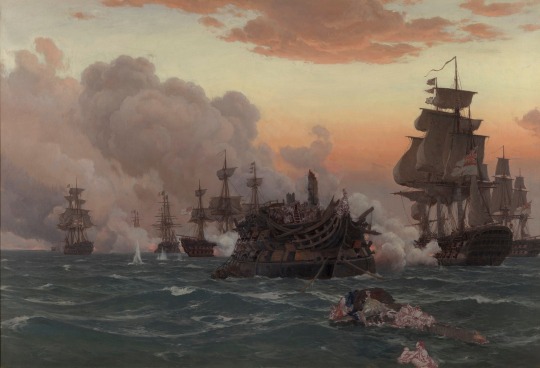
The Battle of the Nile, 1 August 1798
by Eduardo de Martino
#eduardo de martino#art#battle of the nile#horatio nelson#age of sail#mediterranean#egypt#france#england#aboukir bay#royal navy#great britain#britain#history#french revolutionary wars#ships#fleet#naval battle#naval battles#french#english#british#naval warfare#napoleonic#warship#warships
245 notes
·
View notes
Photo

British line infantry land under fire at Aboukir Bay on 8 March 1801. By Aleksandr Yezhov
#aboukir bay#battle of aboukir bay#history#military history#british army#redcoat#redcoats#napoleonic#napoleonic wars#19th century
40 notes
·
View notes
Photo
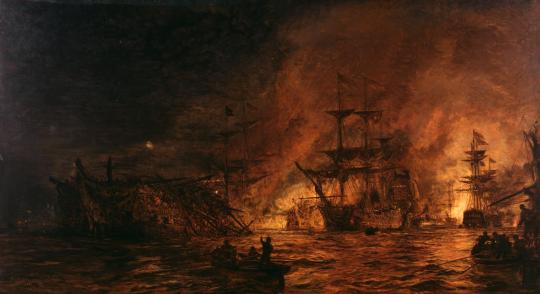
The Battle of the Nile by William Lionel Wyllie, 1899.
33 notes
·
View notes
Text

Battle of the Nile at Aboukir Bay 1798, by Ivan Berryman 2016
63 notes
·
View notes
Text
Napoleon in Egypt: *establishes a brilliantly politically savvy plan to use an invasion in Egypt to eventually sever the link between Britain and India, ultimately crippling the British economy and forcing them out of the war!*
Nelson: “Hold my wine, imma ruin this guy’s day”
*proceeds to obliterate the fleet, trapping 45k French soldiers in Egypt, establishing British naval dominance in the Mediterranean and turning several other European nations against France*
#musings#Nelson was just a few hours behind the French fleet for TWO MONTHS#Napoleon knew and ordered absolute secrecy for plans#Nelson spotted them in Aboukir bay and just immediately ordered an attack#it’s the victory that made Nelson a household name because his strategy was risky but in all truth genius
0 notes
Text
Events 8.1 (before 1900)
30 BC – Octavian (later known as Augustus) enters Alexandria, Egypt, bringing it under the control of the Roman Republic. AD 69 – Batavian rebellion: The Batavians in Germania Inferior (Netherlands) revolt under the leadership of Gaius Julius Civilis. 527 – Justinian I becomes the sole ruler of the Byzantine Empire. 607 – Ono no Imoko is dispatched as envoy to the Sui court in China (Traditional Japanese date: July 3, 607). 902 – Taormina, the last Byzantine stronghold in Sicily, is captured by the Aghlabid army, concluding the Muslim conquest of Sicily. 1203 – Isaac II Angelos, restored Byzantine Emperor, declares his son Alexios IV Angelos co-emperor after pressure from the forces of the Fourth Crusade. 1291 – The Old Swiss Confederacy is formed with the signature of the Federal Charter. 1469 – Louis XI of France founds the chivalric order called the Order of Saint Michael in Amboise. 1498 – Christopher Columbus becomes the first European to visit what is now Venezuela. 1571 – The Ottoman conquest of Cyprus is concluded, by the surrender of Famagusta. 1620 – Speedwell leaves Delfshaven to bring pilgrims to America by way of England. 1664 – Ottoman forces are defeated in the battle of Saint Gotthard by an Austrian army led by Raimondo Montecuccoli, resulting in the Peace of Vasvár. 1714 – George, Elector of Hanover, becomes King George I of Great Britain, marking the beginning of the Georgian era of British history. 1759 – Seven Years' War: The Battle of Minden, an allied Anglo-German army victory over the French. In Britain this was one of a number of events that constituted the Annus Mirabilis of 1759 and is celebrated as Minden Day by certain British Army regiments. 1774 – British scientist Joseph Priestley discovers oxygen gas, corroborating the prior discovery of this element by German-Swedish chemist Carl Wilhelm Scheele. 1798 – French Revolutionary Wars: Battle of the Nile (Battle of Aboukir Bay): Battle begins when a British fleet engages the French Revolutionary Navy fleet in an unusual night action. 1800 – The Acts of Union 1800 are passed which merge the Kingdom of Great Britain and the Kingdom of Ireland into the United Kingdom of Great Britain and Ireland. 1801 – First Barbary War: The American schooner USS Enterprise captures the Tripolitan polacca Tripoli in a single-ship action off the coast of modern-day Libya. 1834 – Slavery is abolished in the British Empire as the Slavery Abolition Act 1833 comes into force, although it remains legal in the possessions of the East India Company until the passage of the Indian Slavery Act, 1843. 1834 – Construction begins on the Wilberforce Monument in Kingston Upon Hull. 1842 – The Lombard Street riot erupts in Philadelphia, Pennsylvania, United States. 1849 – Joven Daniel wrecks at the coast of Araucanía, Chile, leading to allegations that local Mapuche tribes murdered survivors and kidnapped Elisa Bravo. 1855 – The first ascent of Monte Rosa, the second highest summit in the Alps. 1863 – At the suggestion of Senator J. V. Snellman and the order of Emperor Alexander II, full rights were promised to the Finnish language by a language regulation in the Grand Duchy of Finland. 1876 – Colorado is admitted as the 38th U.S. state. 1893 – Henry Perky patents shredded wheat. 1894 – The Empire of Japan and Qing China declare war on each other after a week of fighting over Korea, formally inaugurating the First Sino-Japanese War.
0 notes